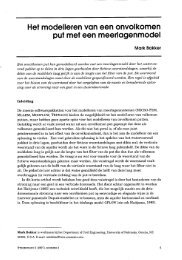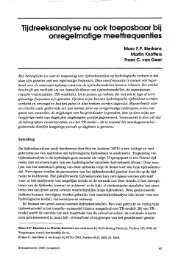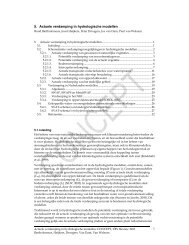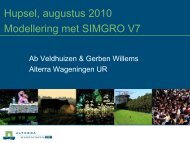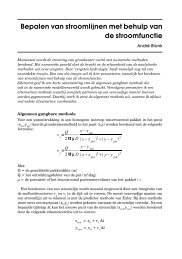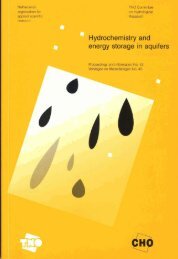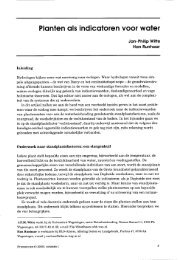PDF Viewing archiving 300 dpi - NHV.nu
PDF Viewing archiving 300 dpi - NHV.nu
PDF Viewing archiving 300 dpi - NHV.nu
You also want an ePaper? Increase the reach of your titles
YUMPU automatically turns print PDFs into web optimized ePapers that Google loves.
used. The arithmetic means of the records of these data were taken as the true areal<br />
precipitation depth.<br />
The areal precipitation depths of 72 10-day periods were estimated with 1, 2 and 5<br />
stations of the national rain gauge network, respectively, each covering about 1000,500<br />
and 200 km2, respectively. As the five stations were not evenly distributed over the area,<br />
the "Thiessen average" was taken as an estimate. These estimates were compared with the<br />
"true" precipitation depth obtained with the dense network. The respective values of Z<br />
were calculated; they are plotted in Figure 10. In this figure, also the theoretical line<br />
given by equation (10) is drawn. It is seen that there is fairly good agreement between<br />
experimental and theoretical values of Z. It can be shown that (10) underestimates Z, if<br />
the stations are not evenly distributed. This explains the rather big deviation of the experimental<br />
2-value for S/N = 200 km2.<br />
The same procedure was followed for daily totals. The results for 1000, 100 and<br />
1 km2 are given in Figures 11 and 12. Again, there is agreement although with a tendency<br />
that (1 0) underestimates 2.<br />
Unfortunately, the procedure under consideration only gives a few examples for<br />
testing equation (10); it is, therefore, dangerous to draw definite conclusions.<br />
Finally, similar experiments are being considered, carried out by Kruizinga and Yperlaan,<br />
1976 with the records of 35 stations situated in the province of Zuid Holland, in the<br />
western part of the Netherlands. The total area was about 4000 km2.<br />
The mean daily precipitation depth over this area was estimated with the daily records<br />
of 4 stations, and the average over a sub-area of about 400 km2 was estimated with the<br />
measurements at 1, 3 and 4 points, respectively. In the case of four points, the stations<br />
were situated outside the area.<br />
Kruizinga and Yperlaan did not use quantity Z as a measure of error of estimate. They<br />
took the mean of the absolute value of the differences between the estimate and the true<br />
areal rainfall depth. So, in the first instance, their results are not comparable with<br />
equation (10). However, experiments with the records of the "Salland network" reveal<br />
that the "mean absolute difference" error is about 0.5 times the "root mean square"<br />
error, from which Z is derived. This is partly due to the sensitiveness of Z to outliers.<br />
Using this conversion factor, we plotted the results of Kruizinga and Yperlaan in<br />
Figure 13, where also the theoretical lines for 400 and 4000 km2<br />
It should be noted that Kruizinga and Yperlaan described the error of estimates as a<br />
function of the "true" areal rainfall depth and the four seasons, while dry days were also<br />
concerned. The values given in Figure 13 are recalculated for rainy days. No distinction<br />
is made between the rainfall depth and the seasons.<br />
Again, it can be concluded that equation (10) fits fairly well to the experimental<br />
values of Z. However, we should bear in mind that the experimental values of Z for this<br />
example were obtained in a rather crude way.<br />
ACKNOWLEDGEMENT<br />
The author is greatly indebted to Mr. S. Kruizinga for valuable advice.





